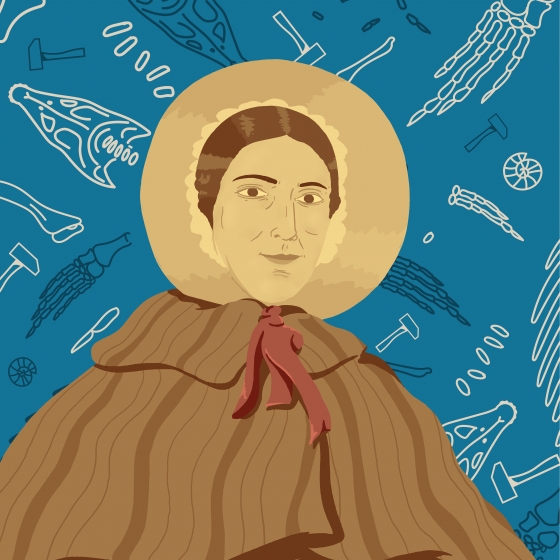
Mary Anning
An unlikely contributor at the founding of palaeontology.
Mary Anning was born into a working-class family in Dorset, England, on 21 May 1799. She was the third of ten children and only one of two to survive to maturity.1 Anning’s father, Richard Anning, was a cabinetmaker who collected fossils along with Lyme Regis in an area now known as the ‘Jurassic Coast’.2 Fossil collecting was a family hobby and business – Anning and her brother would often accompany their father and learnt to find and clean fossils. The family ran a shop where they would sell the fossils to supplement their income. In 1810, when Anning was around 10 or 11, her father died unexpectedly, leaving the family in poverty.3 To support the family, Anning’s brother, then 14, worked as an upholsterer while Anning and their mother continued to collect and sell fossils.4
Anning was meticulous in documenting and recording her finds. In 1810, Anning’s brother found a fossilised crocodilian skull and a 12-year-old Anning then revealed the rest of the skeleton. Years later, the skeleton would be identified as a new species – the ichthyosaur. Despite Anning’s obvious scientific flair, in the early 19th century, the English working class were excluded from quality schooling.5 However, the church that Anning’s family attended was among the English Dissenters and believed in educating the poor, contrary to the teachings of the Church of England.6 Anning was taught to read and write at Sunday school. Furthermore, women were prohibited from attending University. Anning overcame the knowledge barriers of classism and sexism by borrowing scientific literature and hand copying it to study at home. She would also dissect fish and reptiles to supplement her knowledge. She developed a knowledge of geology and anatomy that was later described as superseding established scientists in the field.7
Anning became well known among the geological community. Anning’s self-taught scientific knowledge enabled her to do more than merely sell fossils to collectors. She found, cleaned, prepared, documented and even classified them. Established collectors and geologists would purchase the fossils and discuss Anning’s research. As was commonplace in 19th century England, it was the wealthy collectors and geologists who would publish scientific papers on the finds, often without crediting the working-class people responsible for them.4 Anning’s discoveries contributed to the acceptance of George Cuvier’s Theory of Extinction which claimed that species could become extinct – an idea that faced strong opposition from the Church of England.8 Furthermore, it was Anning who first identified that small rocks often found near fossils were fossilised faeces, later coined as coprolites.4
At the age of 47, Mary Anning died of cancer. Despite being a key figure in the founding of palaeontology, Anning is credited with authorship of a single publication – a letter written to E. Charlesworth, editor of The Magazine of Natural History in 1839.9 Charlesworth published an excerpt from the letter, where Anning refuted an inaccurate conclusion posited about one of her discoveries. The letter displays her powerful scientific knowledge and ability, and the publication of the letter shows the degree of respect Anning earned from the scientific community, despite being excluded from it.
-
To me, Mary Anning’s life story is bittersweet. I was drawn to her story by her struggle. Her life exemplifies that sexism and classism are more than just minor hindrances. Every aspect of Anning’s life was made more difficult than it should have been. Mary’s life was hard. She wrote of herself that “the world has used me so unkindly”. I believe it is important to remember stories like Anning’s. If Anning was born today, she wouldn’t be prevented from attending university by her sex. However, her socioeconomic background would reduce the chance of her completing secondary schooling. I can say, with first-hand experience, that gaining tertiary qualifications without a complete secondary education is considerably difficult and not at all likely. Mary Anning’s story resonates with me and highlights the need to continue dismantling societal inequalities, particularly regarding the quality of education.
-
Josh McCluskey is a current third year student in the school Biotechnology and Biomolecular Sciences and is pursuing a PhD in Biotechnology.
-
- Goodhue, Thomas W. (2002), Curious Bones: Mary Anning and the Birth of Paleontology (Great Scientists), Morgan Reynolds, ISBN 978-1-883846-93-0
- "World Heritage Committee Inscribes 31 New Sites on the World Heritage List". UNESCO. 14 December 2001. Retrieved 9 September 2016.
- E. Welch, 'Lady Silvester's tour through Devonshire in 1824', Devon and Cornwall Notes and Queries (1967), 30, 313 and (1973), 32, 265-6.
- Torrens, H. (1995). Mary Anning (1799–1847) of Lyme; ‘the greatest fossilist the world ever knew’. The British Journal for the History of Science, 28(3), 257-284. doi:10.1017/S0007087400033161
- John Roach (1986) Boys and girls at school, 1800‐70, History of Education, 15:3, 147-159, DOI: 10.1080/0046760860150302
- Parker, Irene (1914) Dissenting academies in England: their rise and progress, and their place among the educational systems of the country (2009 2nd ed.). Cambridge University Press. ISBN 978-0-521-74864-3.
- Davis, Larry E. (2012) "Mary Anning: Princess of Palaeontology and Geological Lioness," The Compass: Earth Science Journal of Sigma Gamma Epsilon: Vol. 84: Iss. 1, Article 8.
- Rudwick, Martin J.S. (2008), Worlds Before Adam: The Reconstruction of Geohistory in the Age of Reform, The University of Chicago Press, ISBN 978-0-226-73128-5
- Extract of a letter from Miss Anning. Magazine of Natural History (1839), new series 3, 605.
Artwork developed by Thomas Bell and Caroline Fox Drinkwater.
